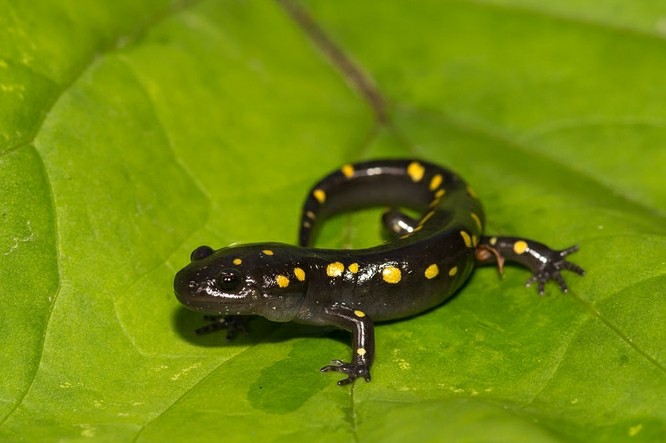Salamanders are small, quiet creatures that often go unnoticed in the wild. But if you’ve ever watched one closely, you might wonder, can they really change color like chameleons?
Salamanders can change color, but the changes are slow and subtle. They do it to help them blend in, to attract mates, or when they’re stressed. It’s not a quick or dramatic shift, but it’s still a clever trick that helps them survive.
What Exactly Is a Salamander?
Before we get into how they change color, let’s get to know salamanders a little better. Salamanders are amphibians, which means they live part of their lives in water and part on land.
They have moist, smooth skin and long tails. Most are small, but some can grow surprisingly big.
You’ll find salamanders in damp, shady places, forests, streams, ponds, and even mountain areas.
There are over 700 different kinds, and most live in North America and Europe.
People often mistake them for lizards, but they’re not the same at all. Lizards are reptiles with dry, scaly skin.
Salamanders breathe through their skin, and they often start life in water with gills, just like tadpoles.
How Salamanders Change Color
Salamanders can change their color, but not in the dramatic way some other animals can.
Their color changes happen slowly and are often hard to notice unless you’re really paying attention. Still, these small shifts can make a big difference.
The Special Cells That Do the Work
Salamander skin has tiny cells called chromatophores. These cells hold different pigments, colored stuff that gives skin its tone.
Some cells hold dark pigments, others hold reds, yellows, or even shiny materials that reflect light.
Here are the main ones:
- Melanophores: carry dark pigments like black and brown.
- Xanthophores: hold yellow tones.
- Erythrophores: have red pigments.
- Iridophores: reflect light and give off shiny or blue looks.
When these cells shrink or stretch, the skin color shifts. If the dark cells expand, the salamander gets darker. If they shrink, it looks lighter. It’s a slow, quiet change, but it works.
The Role of the Environment
A salamander doesn’t just change color for fun. It responds to its surroundings. In a dark place, it might turn a little darker to blend in.
In bright spots, it might get lighter. The color change happens gradually.
It’s not fast like flipping a switch, it takes time, and it’s easy to miss if you’re not looking for it.
Why Salamanders Change Color
Color change is part of how salamanders stay alive. It helps them hide, attract mates, and respond to stress.
To Hide from Predators
One of the main reasons salamanders change color is to stay out of sight.
If they match the ground, the leaves, or the water around them, it’s harder for birds or bigger animals to spot them.
This type of hiding is called camouflage. It helps them avoid danger, and sometimes, sneak up on prey.
To Attract a Mate
During breeding season, some salamanders change their colors slightly to catch a mate’s eye.
A brighter color might signal good health. A strong, healthy male might look more vibrant, and that can help him find a partner.
To Show Stress
When a salamander is stressed (maybe from sudden changes in temperature, handling, or habitat problems), it might turn duller or darker.
This could be a way to protect itself by appearing less noticeable, or even unhealthy, so predators might not bother with it.
Real Examples of Salamander Color Change
Eastern Newt
The Eastern newt shows some of the most dramatic changes. As babies in the water, they’re bright green.

When they move onto land, they become orange-brown. Later, as adults back in the water, they turn olive-green.
These changes help them blend into their new homes at each stage of life.
Tiger Salamander
Tiger salamanders come in different patterns; some have stripes, others have spots.

They don’t change color as much over time, but they can adjust slightly depending on their surroundings. These shifts are slow and small.
Spotted Salamander
Spotted salamanders are known for their dark bodies and bright yellow or white spots.

During mating season, they might become just a little bit brighter. It’s a subtle shift, but scientists think it might help with attracting mates, though more research is needed.
Conclusion
Salamanders can change color, but it’s not quick or flashy. The changes are slow and gentle, often happening over hours or days.
They do it to hide, to find a mate, or to react to stress. Special skin cells help make these shifts, even if you can’t always see them happening.
Some salamanders, like the Eastern newt, go through major color changes as they grow. Others make tiny adjustments to match their surroundings. Every change serves a purpose.
By learning how salamanders change color, we get a better look at how nature works, and why even the smallest creatures are worth protecting.
These quiet, slippery animals have something to teach us, if we just slow down and watch.
Hi, my name is Ezra Mushala, i have been interested animals all my life. I am the main author and editor here at snakeinformer.com.

